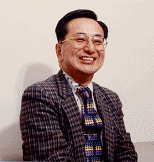Å@

Yoshio Oyanagi
Dean, Faculty of Informatics, Kogakuin University
Supercomputing in JapanÅ@
Yoshio Oyanagi
Dean, Faculty of Informatics, Kogakuin University
Å@
<Abstract>The first vector computers in Japan came out in a couple of years after the shipment of Cray-1 (1976), although the performance was not comparable to that of the Cray-1. Since the first half of the 1980s, Japanese computer vendors have been producing a number of powerful supercomputers for solving large scale scientific and engineering problems. In contrast to the supercomputers in US, Japanese vector computers were designed as an extension of the mainframe computers and were equipped with highly multiple vector pipes in one processor. Parallel architecture was introduced to Japanese supercomputers finally around 1990 and at present only NEC manufactures parallel vector computers while Fujitsu and Hitachi produce parallel scalar computers with performance enhancement.
One of the characteristics of Japanese high performance computers is the influence of dedicated computer projects to commercial supercomputers. The technology of the NWT (Numerical Wind Tunnel, 1993), which was developed by NAL and Fujitsu, was commercialized as Fujitsu VPP-500; the pseudovector feature of the cp-pacs (1996), which was developed by University of Tsukuba and Hitachi, was also prominent in HITAC SR2201; the one-chip vector processor, which was developed for the Earth Simulator (2002), was used in NEC SX-6 supercomputers.
In these cases, Japanese vendors profited by the expertise of national laboratories and universities. On the other hand, as an ecosystem, single dedicated computer cannot live without constant support, which would be available only if the industry supplies commercial products using the same technology. Japan is going to start so-called Keisoku (10 PFlops) Computer Project, to which the author will give a technological prospect.
<Biographical Notes>Present
Dean, Faculty of Informatics, Kogakuin University
Å@
Education
1962Å|1966 Undergraduate Student in Department of Physics, University of Tokyo University of Tokyo, Obtained B. Sc.
1966Å|1971 Graduate Student in Department of Physics, University of Tokyo University of Tokyo, Obtained Ph.D. (Thesis advisor; Prof. Miyazawa)
Å@
Academic Career
1971Å|1973 Research Associate, Department of Physics, University of Tokyo (Prof. Yamaguchi's laboratory)
1973Å|1978 Research Associate, KEK, National Laboratory for High Energy Physics (Theory Division)
1978Å|1982 Assistant Professor, Institute of Information Sciences, University of Tsukuba
1982Å|1988 Associate Professor, Institute of Information Sciences, University of Tsukuba
1988Å|1991 Professor, Institute of Information Sciences, University of Tsukuba
1991Å|2001 Professor, Department of Information Science, University of Tokyo
2001Å|2006 Professor, Department of Computer Science, University of Tokyo
2006Å| Professor and Dean, Faculty of Informatics, Kogakuin University
Å@
Academic Awards
2006 Science and Technology Award by Minister of Education, Culture, Sports, Science and Technology (Tokyo)
The author has been working in the fields of theoretical particle physics, lattice gauge simulation, vector and parallel computing, numerical analysis, parallel algorithms. He joined the projects to develop dedicated parallel computers, QCD-PAX and cp-pacs.
Å@